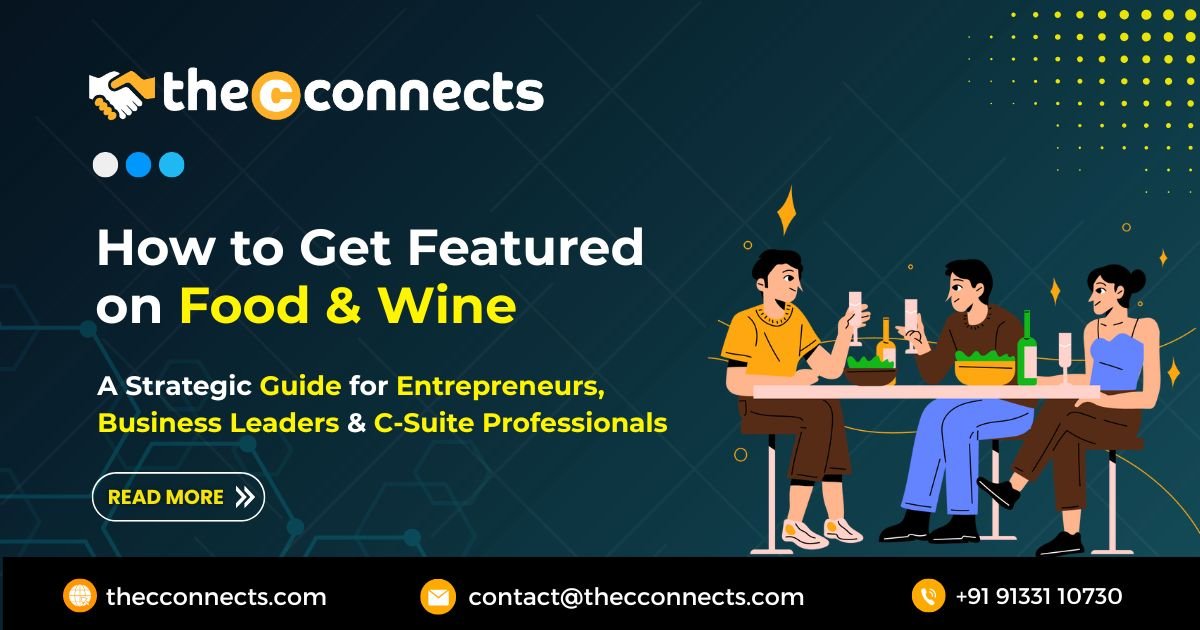In today’s highly competitive business and media landscape, securing a feature in a prestigious media outlet like Food & Wine is more than just prestige-it’s a powerful platform for thought‑leadership, brand building and strategic visibility. For entrepreneurs, CEOs, and innovation‑driven company leaders, a byline or quoted piece in Food & Wine offers a unique opportunity to reach an audience interested not only in food and drink, but in lifestyle, culture, business innovation and the intersection of hospitality with entrepreneurship.
At TheCconnects Magazine, we specialise in enabling corporate leaders, authors and consultants to craft compelling features, guest posts and thought‑leadership articles-and get them placed in publications like Food & Wine. Here is your in‑depth roadmap, from understanding the publication to crafting your pitch, writing the article, and leveraging the exposure once you are published.
1. Why Food & Wine Matters for Business & Thought‑Leadership
Food & Wine is a globally recognised publication that celebrates the best in food, drink, travel and culinary culture. It has long been regarded as a brand that elevates not just recipes, restaurants or wine tastings-but also the stories and business‑innovations behind the scenes.
For business leaders and entrepreneurs, being featured in Food & Wine brings several concrete benefits:
- Credibility and brand positioning: A feature places you among the world’s best in your domain; for example, not only food business CEOs but also hospitality‑tech founders, food‑service innovators, vertical‑farming entrepreneurs and beverage brand creators.
- Visibility to an affluent and influential readership: Food & Wine’s audience includes sophisticated consumers, investors, high‑net‑worth individuals and industry insiders-people who both consume and influence trends.
- Thought‑leadership beyond your niche: You move beyond standard business outlets into lifestyle, culture and consumer‑facing media, thereby expanding your personal or corporate reach.
- SEO and digital footprint: Online features carry domain authority and persistent visibility-great for your personal brand and business marketing.
2. Understanding Food & Wine’s Editorial Focus & Audience
To get featured, you must understand both what Food & Wine publishes and who reads it:
- Editorial themes: The magazine publishes features on recipes, techniques, global ingredients, dining trends, wine & spirits, travel and cultural narratives tied to food. But increasingly also profiles of brands, chefs and innovators driving change. Its contributor guidelines emphasise that they “are interested in pitches from writers, recipe developers, and photographers with a broad range of perspectives and backgrounds” and that ideas must inspire and empower the audience.
- Lead time and exclusivity: For print, lead times are long-assignments may be made 10 months to a year out.
- Audience: While food‑ and wine‑centric, the readership includes business‑minded individuals curious about lifestyle, brand innovation, sustainability, entrepreneurship in the food sector and more.
- Diversity and storytelling: Food & Wine is committed to inclusive storytelling, reflecting diverse voices and global perspectives.
Knowing this helps you tailor your story idea and tone to match their expectations-and stand out.
3. Designing Your Feature Strategy: Topic & Angle
Because Food & Wine covers a wide domain, you’ll need a strategic angle-especially for corporate‑leaders, entrepreneurs and authors. Here are steps and examples:
A. Identify your expertise & unique value
- What business/brand story do you bring? For instance: you launched a fruit‑farming business that uses AI to optimise yield and reduce waste-tying food + tech + sustainability.
- Are you a C‑Suite leader in a hospitality chain implementing a sustainability campaign? Or an entrepreneur with a vertical‑farming brand disrupting supply‑chains?
- Your credibility matters: experience, outcomes, uniqueness.
B. Match the editorial themes
- Trends in food innovation (lab‑grown meat, plant‑based proteins)
- Business of hospitality or beverage brands
- Sustainability, supply‑chain transparency, social impact in food & drink
- Global cuisine experiences tied to culture and business
- Leadership stories behind chef‑entrepreneurs, brand founders
C. Craft the compelling hook
- Example: “How our family‑owned craft gin brand scaled from zero to 50 + premium restaurants via storytelling and sustainability”
- Example: “Redefining the dining experience: how the C‑Suite at [Company] uses immersive tech to blend gastronomy and culture”
- Make clear: reader benefit-what will the Food & Wine audience learn? Something actionable, surprising, relevant.
4. Crafting the Pitch & Submission to Food & Wine
Here’s how you build a professional pitch:
Subject line: PITCH: [Working Title] – Feature Idea for Food & Wine
Email body should include:
- Greeting (address editor by name if known, e.g., Chandra Ram etc.)
- Short intro: your name, title, company, credentials
- Working headline + 2‑3 paragraph summary of the story idea
- 3–5 bullet points of what reader will learn or take away
- Why you are the ideal contributor: credentials, unique angle
- Mention you can provide high‑res imagery, interviews, etc.
- Note: “Original content, not previously published; open to edit & adapt to your style.”
- Attach CV/clips if you have previous publications.
Follow‑up advice: Because of long lead times (up to 10 months) and limited print slots, if your pitch is very timely, indicate willingness for online feature.
5. Writing the Article: Structure & SEO Considerations
Once your pitch is accepted, you’ll draft the full article (typically 1,000–1,500 words, but check with editor). When writing, keep these in mind:
- SEO keywords: Incorporate relevant terms naturally-e.g., “food innovation,” “sustainable beverage startup,” “culinary leadership,” “premium gin brand growth,” depending on your topic.
- Strong opening: Start with a compelling anecdote or statistic. For example: “When we launched our distillery in 2018, we didn’t just compete with spirits-we set out to build a culture of ‘craft gin meets narrative’. Today we’re in 60 countries.”
- Clear sub‑headings: Help readability; online readers often skim.
- Data and proof‑points: Use numbers, case‑studies: revenue growth, sustainability metrics, brand expansion, partnership outcomes.
- Actionable take‑aways: “Here are three leadership lessons we learned…” “Four steps to scale a food brand globally…”
- Visuals: Offer high‑quality images of the brand, packaging, production site, founder portrait.
- Conclusion & CTA: Conclude with your thinking on future trends and a subtle reference to your role.
6. Leveraging TheCconnects for Submission & Amplification
At TheCconnects we support you in three key ways:
- Content strategy & topic ideation: Based on your business/brand, we help hone the story that aligns with Food & Wine’s audience and your goals.
- Editorial polish: We refine your draft, guide SEO optimisation, ensure clarity for C‑Suite readability and digital audience.
- Outreach & amplification: We liaise with the publication if needed, manage follow‑up, and post‑publication we help amplify via our network across LinkedIn, podcasts, media placements.
Our value: you get expert editorial support + publishing network, freeing you to focus on your core message. Ready when you are-just drop us a line.
7. Post‑Publication Promotion & Measurement
Once your article is live, maximise its impact:
- Share it broadly: Post on LinkedIn, tag relevant people/publication, share with your network and stakeholders.
- Engage the audience: Respond to comments, initiate discussion around the theme (“What’s your approach to food‑brand scalability?”)
- Repurpose the content: Use excerpts in blogs, newsletters, your company site. Perhaps host a webinar based on the feature.
- Measure results: Monitor social reach, website traffic, inbound leads, speaking engagements or media queries derived from your feature.
- Build the portfolio: Keep the Food & Wine link in your media kit, press page; this becomes evidence of authority for future articles or speaking slots.
8. Final Words & Next Steps
Getting featured on Food & Wine is a strategic move-not just for brand exposure in food/lifestyle media but for positioning yourself or your company at the intersection of business innovation, culture and consumer markets. To succeed, you need: a compelling story with relevance to their audience; professional pitching and writing; and smart follow‑through to leverage the feature.
At TheCconnects Magazine, we’re ready to partner with you every step of the way: ideation, writing, outreach and promotion. If you’re ready to craft your feature and get placed in Food & Wine, reach out now:
📧 contact@thecconnects.com
📞 +91 91331 10730
🟢 WhatsApp https://wa.me/919133110730



